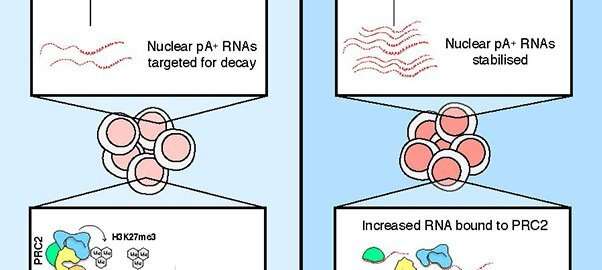RNA regulation is crucial for embryonic stem cell differentiation

Embryonic stem cells (ESCs) are distinguished by their dual ability to self-renew and their potential to differentiate, both of which require tight regulatory control. During the differentiation of ESCs, various cells develop into specialised cell types such as skin cells, nerve cells, muscle cells, etc. While our understanding of ES cell regulation has been dominated by transcriptional and epigenetic models, the role of post-transcriptional regulation via nuclear RNA decay has remained less explored.
Now a Danish research team has identified a disruptive relationship between excess nuclear RNA levels, regulated by the PolyA-tail eXosome Targeting' (PAXT) connection, and transcriptional control by the Polycomb Repressive Complex 2 (PRC2). The researchers propose that excess RNA hampers PRC2 function through its sequestration from DNA. Their results highlight the importance of balancing nuclear RNA levels and demonstrate the capacity of bulk RNA to regulate chromatin-associated proteins.
Previously, the Torben Heick Jensen Laboratory had identified and characterised the PAXT connection as an adaptor complex that targets polyadenylated (pA+) RNAs to the nuclear RNA exosome for decay. Upon depletion of PAXT components, including the zinc-finger protein ZFC3H1, cells stabilise and accumulate pA+ RNAs. This allows an approach to study the general effects of excess pA+ RNA in the nucleus.
Interestingly, removal of the PAXT component ZFC3H1 using CRISPR/Cas9 in mouse ESC subsequently disrupted their ability to differentiate. High throughput sequencing analysis revealed that Zfc3h1-/- knockout (KO) ES cells showed increased expression of differentiation associated RNAs that are usually silenced by the PRC2 complex. Upon further investigation, it was shown that the function and stability of the PRC2 complex was compromised due to excess binding of RNA as a consequence of Zfc3h1-/- KO. Together, this highlights the importance of maintaining a stable nuclear transcriptome through active RNA decay to prevent off-target effects as a result of RNA accumulation.
These findings are a result of a collaborative project between the laboratories of Torben Heick Jensen at the Department of Molecular Biology and Genetics, Aarhus University, and Kristian Helin at the Biotech Research and Innovation Centre, Copenhagen University, financed by the Novo Nordisk Foundation Center for Stem Cell Biology (DanStem) to investigate the role of RNA regulation in ES cell biology. The studies are primarily carried out by Will Garland from Aarhus University.
This study was published in the internationally recognised journal Cell Reports.
More information: William Garland et al, A Functional Link between Nuclear RNA Decay and Transcriptional Control Mediated by the Polycomb Repressive Complex 2, Cell Reports (2019). DOI: 10.1016/j.celrep.2019.10.011
Journal information: Cell Reports
Provided by Aarhus University



















